Influenza orthomyxovirus - Study guides, Class notes & Summaries
Looking for the best study guides, study notes and summaries about Influenza orthomyxovirus? On this page you'll find 47 study documents about Influenza orthomyxovirus.
Page 4 out of 47 results
Sort by

-
BIO 171 Module 6 Exam (Questions & Answers) (V2)- Microbiology- Portage Learning | 100% VERIFIED
- Exam (elaborations) • 13 pages • 2022
-
- $10.99
- + learn more
BIO 171 Module 6 Exam M6: Module 6 Exam- Requires Respondus LockDown Browser Due No due date Points 100 Questions 30 Time Limit 60 Minutes Requires Respondus LockDown Browser Attempt History Att empt Time Score LATEST Attempt 1 60 minutes 84 out of 100 Score for this quiz: 84 out of 100 Submitted Mar 8 at 11:50pm This attempt took 60 minutes. Question 1 2 / 2 pts True or False. Although viruses may contain their genome within an enclosed space (much like the nucleus of a cell), it is considered ...

-
BIOD 171 MICROBIO EXAM
- Exam (elaborations) • 33 pages • 2022
-
- $15.49
- + learn more
BIOD 171 MICROBIO EXAM answers 1. A virus is classified as a microbe.True. Although viruses are not living and as such are not considered microorganisms, they can, however, be classified as microbes, a more general term that includes microorganisms and viruses. 2. True or False: The smallest biological unit of life is the molecule.False. The smallest biological unit of life is the cell. 3. What are the 4 main types of macromolecules found in cells?Proteins, Lipids, Nucleic acids and Polys...
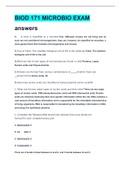
-
BIOD 171 MICROBIO EXAM
- Exam (elaborations) • 33 pages • 2022
-
- $15.49
- + learn more
BIOD 171 MICROBIO EXAM answers 1. A virus is classified as a microbe.True. Although viruses are not living and as such are not considered microorganisms, they can, however, be classified as microbes, a more general term that includes microorganisms and viruses. 2. True or False: The smallest biological unit of life is the molecule.False. The smallest biological unit of life is the cell. 3. What are the 4 main types of macromolecules found in cells?Proteins, Lipids, Nucleic acids and Polys...
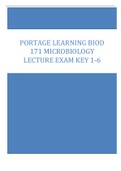
-
PORTAGE LEARNING BIOD 171 MICROBIOLOGY LECTURE EXAM KEY 1-6
- Exam (elaborations) • 35 pages • 2022
-
- $17.49
- + learn more
PORTAGE LEARNING BIOD 171 MICROBIOLOGY LECTURE EXAM KEY 1-6 How many different types of amino acids are available from which to make proteins? 20 2. Define an essential amino acid. An essential amino acid cannot be produced by the human body and as such must be take in from the environment through alternative sources (i.e) food. 1. What are the two major types of nucleic acids and their roles? There are two major types of nucleic acids: DNA (deoxyribonucleic acid) and RNA (ribonuclei...
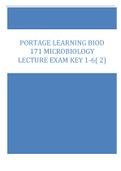
-
PORTAGE LEARNING BIOD 171 MICROBIOLOGY LECTURE EXAM KEY 1-6( 2)
- Exam (elaborations) • 35 pages • 2022
-
- $17.49
- + learn more
PORTAGE LEARNING BIOD 171 MICROBIOLOGY LECTURE EXAM KEY 1-6( 2) How many different types of amino acids are available from which to make proteins? 20 2. Define an essential amino acid. An essential amino acid cannot be produced by the human body and as such must be take in from the environment through alternative sources (i.e) food. 1. What are the two major types of nucleic acids and their roles? There are two major types of nucleic acids: DNA (deoxyribonucleic acid) and RNA (ribonu...

-
BIOD 171 Portage Learning Final EXAM Questions and Answers 100%Correct/Exam 1-7 2023/2024 Update
- Exam (elaborations) • 30 pages • 2024
-
- $7.49
- + learn more
BIOD 171 Portage Learning Final EXAM Questions and Answers 100%Correct/Exam 1-7 2023/2024 Update True/False. A virus is considered a microorganism. - correct answer-False, Viruses are not living and as such are not considered microorganisms. Viruses can, however, be classified as microbes, a more general term that includes microorganisms and viruses. What is the smallest biological unit of life? - correct answer-A cell What are the four main types of macromolecules found in cells? -...
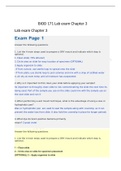
-
BIOD 171FINAL EXAM
- Exam (elaborations) • 5 pages • 2021
- Available in package deal
-
- $11.49
- + learn more
BIOD 171FINAL EXAM BIOD 171FINAL EXAM 1. True or False: A virus is considered a microorganism. False. Viruses are not living and as such are not considered microorganisms. Viruses can, however, be classified as microbes, a more general term that includes microorganisms and viruses. 2. What is the smallest biological unit of life? A cell. 3. At a generalized level, all cells are comprised of what? Macromolecules* *A student may also answer: Proteins, Lipids, Nucleic ac...
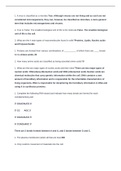
-
BIOD 171Microbio exam answers
- Exam (elaborations) • 29 pages • 2021
- Available in package deal
-
- $11.59
- + learn more
BIOD 171Microbio exam answers 1. A virus is classified as a microbe.True. Although viruses are not living and as such are not considered microorganisms, they can, however, be classified as microbes, a more general term that includes microorganisms and viruses. 2. True or False: The smallest biological unit of life is the molecule.False. The smallest biological unit of life is the cell. 3. What are the 4 main types of macromolecules found in cells?Proteins, Lipids, Nucleic acids and Polysa...
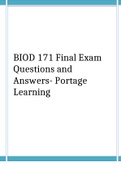
-
BIOD 171 Final Exam Questions and Answers- Portage Learning
- Exam (elaborations) • 7 pages • 2023
-
- $11.49
- + learn more
BIOD 171 Final Exam Questions and Answers- Portage Learning BIOD 171 Final Exam Questions and Answers- Portage Learning FINAL EXAM 1. True or False: A virus is considered a microorganism. False. Viruses are not living and as such are not considered microorganisms. Viruses can, however, be classified as microbes, a more general term that includes microorganisms and viruses. 2. What is the smallest biological unit of life? A cell. 3. At a generalized level, all cells...
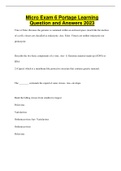
-
Micro Exam 6 Portage Learning Question and Answers 2023
- Exam (elaborations) • 10 pages • 2023
-
- $9.79
- + learn more
Micro Exam 6 Portage Learning Question and Answers 2023 True or False. Because the genome is contained within an enclosed space (much like the nucleus of a cell), viruses are classified as eukaryotic. Ans- False. Viruses are neither eukaryotic nor prokaryotic Describe the two basic components of a virus. Ans- 1) Genomic material made up of DNA or RNA 2) Capsid, which is a membrane like protective structure that contains genetic material. The ________ surrounds the capsid of some virus...

Did you know that on average a seller on Stuvia earns $82 per month selling study resources? Hmm, hint, hint. Discover all about earning on Stuvia


